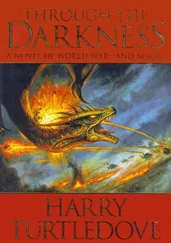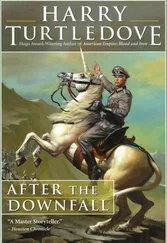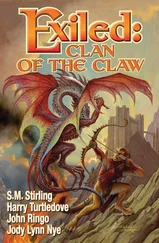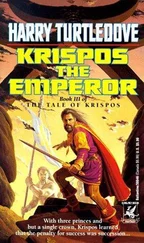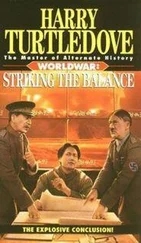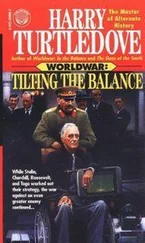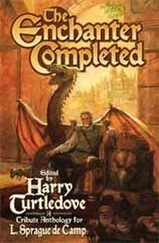“A koprit bird,” Radnal answered. “Most butcherbirds make a larder of things they’ve caught but haven’t got round to eating yet.”
“Oh.” Peggol sounded disappointed. Maybe he’d hoped someone in Trench Park enjoyed tormenting animals, so he could hunt down the miscreant.
Toglo zev Pamdal pointed to the impaled lizard, which looked to have spent a while in the sun. “Do they eat things as dried up as that, Radnal vez?”
“No, probably not,” Radnal said. “At least, I wouldn’t want to.” After he got his small laugh, he continued, “A koprit bird’s larder isn’t just things it intends to eat. It’s also a display to other koprit birds. That’s especially true in breeding season — it’s as if the male says to prospective mates, ‘Look what a hunter I am.’ Koprits don’t display only live things they’ve caught, either. I’ve seen hoards with bright bits of yarn, wires, pieces of sparkling plastic, and once even a set of old false teeth, all hung on spines.”
“False teeth?” Evillia looked sidelong at Benter vez Maprab. “Some of us have more to worry about than others.” Stifled snorts of laughter went up from several tourists. Even Eltsac chuckled. Benter glared at the Highhead girl. She ignored him.
High in the sky, almost too small to see, were a couple of moving black specks. As Radnal pointed them out to the group, a third joined them. “Another feathered optimist,” he said. “This is wonderful country for vultures. Thermals from the Bottomlands floor make soaring effortless. They’re waiting for a donkey — or one of us — to keel over and die. Then they’ll feast.”
“What do they eat when they can’t find tourists?” Toglo zev Pamdal asked.
“Humpless camels, or boar, or anything else dead they spy,” Radnal said. “The only reason there aren’t more of them is that the terrain is too barren to support many large-bodied herbivores.”
“I’ve seen country that isn’t,” Moblay Sopsirk’s son said. “In Duvai, east of Lissonland, the herds range the grasslands almost as they did in the days before mankind. The past hundred years, though, hunting has thinned them out. So the Duvains say, at any rate; I wasn’t there then.”
“I’ve heard the same,” Radnal agreed. “It isn’t like that here.”
He waved to show what he meant. The Bottomlands were too hot and dry to enjoy a covering of grass. Scattered over the plain were assorted varieties of succulent spurges, some spiny, some glossy with wax to hold down water loss. Sharing the landscape with them were desiccated — looking bushes — thorny burnets, oleander, tiny Bottomlands olive plants (they were too small to be trees).
Smaller plants huddled in shadows round the base of the bigger ones. Radnal knew seeds were scattered everywhere, waiting for the infrequent rains. But most of the ground was as barren as if the sea had disappeared yesterday, not five and a half million years before.
“I want all of you to drink plenty of water,” Radnal said. “In weather like this, you sweat more than you think. We’ve packed plenty aboard the donkeys, and we’ll replenish their carrying bladders tonight back at the lodge. Don’t be shy — heatstroke can kill you if you aren’t careful.”
“Warm water isn’t very satisfying to drink,” Lofosa grumbled.
“I am sorry, freelady, but Trench Park hasn’t the resources to haul a refrigerator around for anyone’s convenience,” Radnal said.
Despite Lofosa’s complaint, she and Evillia both drank regularly. Radnal scratched his head, wondering how the Krepalgan girls could seem so fuzzbrained but still muddle along without getting into real trouble.
Evillia had even brought along some flavoring packets, so while everyone else poured down blood-temperature water, she had blood-temperature fruit punch instead. The crystals also turned the water the color of blood. Radnal decided he could do without them.
They got to the Bitter Lake a little before noon. It was more a salt marsh than a lake; the Dalorz River did not drop enough water off the ancient continental shelf to keep a lake bed full against the tremendous evaporation in the eternally hot, eternally dry Bottomlands. Salt pans gleamed white around pools and patches of mud.
“Don’t let the donkeys eat anything here,” Radnal warned. “The water brings everything from the underground salt layer to the surface. Even Bottomlands plants have trouble adapting.”
That was emphatically true. Despite the water absent everywhere else in Trench Park, the landscape round the Bitter Lake was barren even by Bottomlands standards. Most of the few plants that did struggle to grow were tiny and stunted.
Benter vez Maprab, whose sole interest seemed to be horticulture, pointed to one of the exceptions. “What’s that, the ghost of a plant abandoned by the gods?”
“It looks like it,” Radnal said: the shrub had skinny, almost skeletal branches and leaves. Rather than being green, it was white with sparkles that shifted as the breeze shook it. “It’s a saltbush, and it’s found only around the Bitter Lake. It deposits the salts it picks up from ground water as crystals on all its aboveground parts. That does two things: it gets rid of the salt, and having the reflective coating lowers the plant’s effective temperature.”
“It also probably keeps the saltbush from getting eaten very often,” Toglo zev Pamdal said.
“Yes, but with a couple of exceptions,” Radnal said. “One is the humpless camel, which has its own ways of getting rid of excess salt. The other is my little friend the fat sand rat, although it prefers desert spurges, which are juicier.”
The Strongbrow woman looked around. “One of the things I expected to see when I came down here, both the first time and now, was lots of lizards and snakes and tortoises. I haven’t, and it puzzles me. I’d have thought the Bottomlands would be a perfect place for cold-blooded creatures to live.”
“If you look at dawn or dusk, Toglo zev, you’ll see plenty. But not in the heat of the day. Cold-blooded isn’t a good term for reptiles: they have a variable body temperature, not a constant one like birds or mammals. They warm themselves by basking, and cool down by staying out of the midday sun. If they didn’t, they’d cook.”
“I know just how they feel.” Evillia ran a hand through her thick dark hair. “You can stick eating tongs in me now, because I’m done all the way through.”
“It’s not so bad as that,” Radnal said. “I’m sure it’s under fifty hundredths, and it can get above fifty even here. And Trench Park doesn’t have any of the deepest parts of the Bottomlands. Down another couple of thousand cubits, the extreme temperatures go above sixty.”
The non-Tarteshans groaned. So did Toglo zev Pamdal and Peggol vez Menk. Tarteshem had a relatively mild climate; temperatures there went past forty hundredths only from late spring to early fall.
With morbid curiosity, Moblay Sopsirk’s son said, “What is the highest temperature ever recorded in the Bottomlands?”
“Just over sixty-six,” Radnal said. The tourists groaned again, louder.
Radnal led the line of donkeys around the Bitter Lake. He was careful not to get too close to the little water actually in the lake at this time of year. Sometimes a salt crust formed over mud; a donkey’s hoof could poke right through, trapping the animal and slicing its leg against the hard, sharp edge of the crust.
After a while, the tour guide asked, “Do you have all the pictures you want?” When no one denied it, he said, “Then we’ll head back toward the lodge.”
“Hold on.” Eltsac vez Martois pointed across the Bitter Lake. “What are those things over there?”
“I don’t see anything, Eltsac,” his wife said. “You must be looking at a what-do-you-call it, a mirage.” Then, grudgingly, a heartbeat later: “Oh.”
Читать дальше



